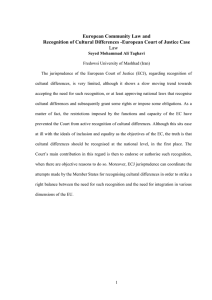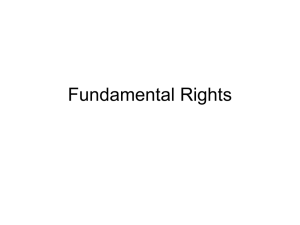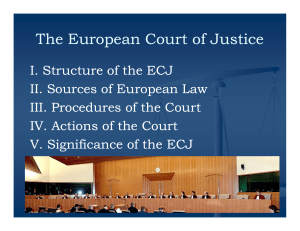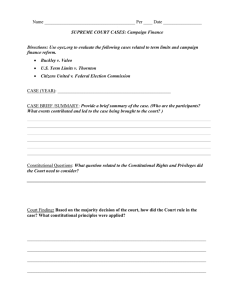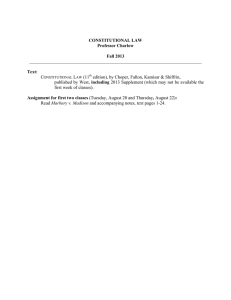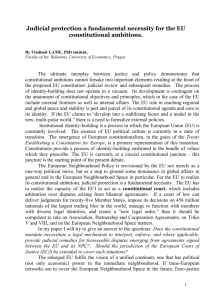Internationale Handelsgesellschaft, Nold and the New Human Rights Paradigm
advertisement
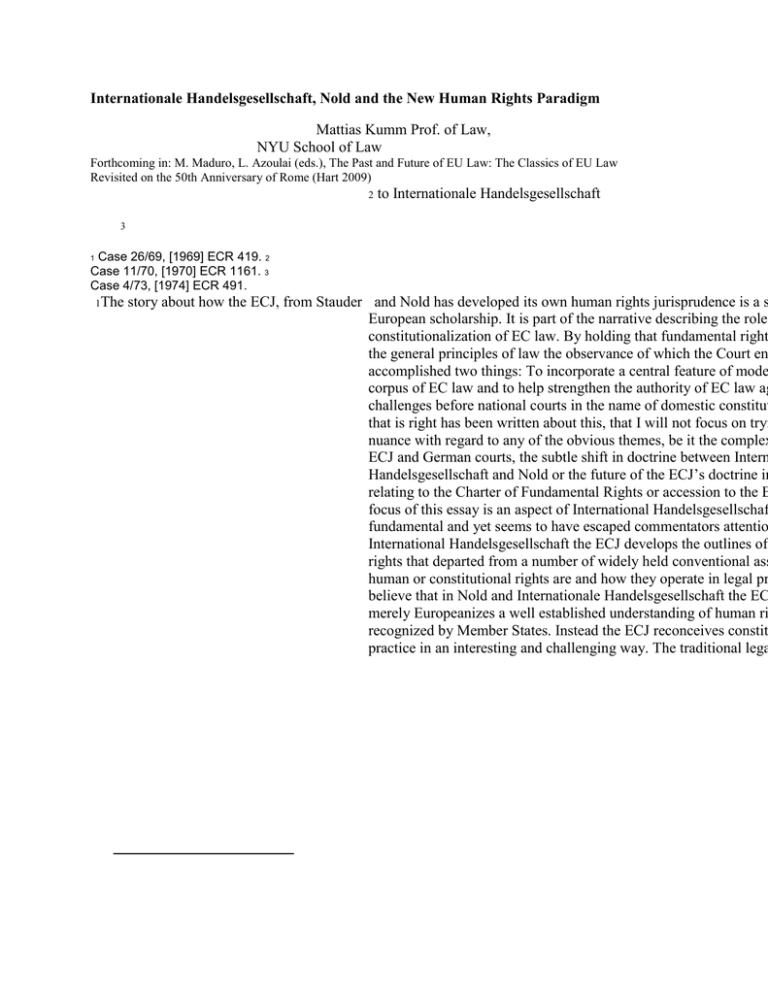
Internationale Handelsgesellschaft, Nold and the New Human Rights Paradigm Mattias Kumm Prof. of Law, NYU School of Law Forthcoming in: M. Maduro, L. Azoulai (eds.), The Past and Future of EU Law: The Classics of EU Law Revisited on the 50th Anniversary of Rome (Hart 2009) 2 to Internationale Handelsgesellschaft 3 Case 26/69, [1969] ECR 419. 2 Case 11/70, [1970] ECR 1161. 3 Case 4/73, [1974] ECR 491. 1 1The story about how the ECJ, from Stauder and Nold has developed its own human rights jurisprudence is a s European scholarship. It is part of the narrative describing the role constitutionalization of EC law. By holding that fundamental right the general principles of law the observance of which the Court en accomplished two things: To incorporate a central feature of mode corpus of EC law and to help strengthen the authority of EC law ag challenges before national courts in the name of domestic constitut that is right has been written about this, that I will not focus on tryi nuance with regard to any of the obvious themes, be it the complex ECJ and German courts, the subtle shift in doctrine between Intern Handelsgesellschaft and Nold or the future of the ECJ’s doctrine in relating to the Charter of Fundamental Rights or accession to the E focus of this essay is an aspect of International Handelsgesellschaf fundamental and yet seems to have escaped commentators attentio International Handelsgesellschaft the ECJ develops the outlines of rights that departed from a number of widely held conventional ass human or constitutional rights are and how they operate in legal pr believe that in Nold and Internationale Handelsgesellschaft the EC merely Europeanizes a well established understanding of human ri recognized by Member States. Instead the ECJ reconceives constit practice in an interesting and challenging way. The traditional lega paradigm of human and constitutional rights is effectively replaced by a rationalist human rights paradigm. In order to substantiate and clarify the claim that the ECJ embraces a new human rights paradigm, the first part this essay will highlight the central features of the ECJ’s conception of human rights and its tension with conventional understandings of human rights. A second part will briefly point to some basic questions on the conceptual, institutional and doctrinal level that such a paradigm shift gives some urgency to. Clearly, a substantial monograph, rather than a short essay would be necessary to more fully develop the themes, substantiate and perhaps qualify the arguments that are made in this essay. But the point of this essay is modest. It is to make aware of a number of mutually reinforcing features in the ECJ’s human rights practice, that give rise to number of distinct questions, that have not received the attention they deserve. II. From Legalism to Rationalism: The New Human Rights Paradigm There are three main features that distinguish the ECJ’s human rights jurisprudence from traditional conceptions of human or constitutional rights. They relate to the scope (1), structure (2) and the sources (3) of human rights respectively. Taken together they amount to a shift from a legalist human rights paradigm to a rationalist human rights paradigm. 1. The scope of human rights: From things fundamental to things mundane The scope of human rights protection is traditionally believed to be limited to interests deemed fundamental. Human or fundamental rights generally become part of debate when the discussion turns to torture, the death penalty, arbitrary police detention, religious coercion, censorship and the like. Typically the lists found in a constitutional Bill of Rights or a Human Rights Treaty are a response to specific historical experiences of blatant disregard of fundamental human interests. One of the reasons that neither the Member states drafting the Treaties of Rome nor the ECJ in its jurisprudence during the 1960s embraced human rights as a matter of concern for EC law, is that the EC as an institution primarily concerned with the establishment of a common market was not active in an area that was believed to raise human rights concerns in any serious way. If by the early 1970s the court changed its mind, it was not because the EC had significantly expanded its competencies – a significant expansion of the EU’s competencies would occur only much later in the context of the Maastricht Treaty and beyond – but because its understanding of human rights had changed. Instead of a set of narrowly circumscribed interests deemed fundamental any kind of liberty interests would enjoy prima facie protection as a right. Human rights were not just about combating the worst kind of dictatorships or government atrocities, human rights were in play the moment the law restricts individual liberty. The language of human rights would play a role not just to point to atrocities and fundamental concerns but to raise complicated questions concerning the most mundane matters. Both Internationale Handelsgesellschaft and Nold illustrate this shift. Internationale Handelsgesellschaft was a case concerning the forfeiture of a deposit lodged in connection with the issue of export licences for maize meal. The plaintiff had failed to export the quantities of maize he had obtained a license for, by all indications because it turned out to be more profitable to sell to a domestic buyer. Under EC rules failure to export after obtaining the licence meant forfeiture of the deposit, unless the failure to export was the result of force majeur. That regime, the plaintiff claimed, violated his general right to freedom of action and economic liberty. In Nold the issue was whether EC rules relating to the distribution of fuels could require companies to meet certain volume of sales requirements in order for them to qualify as a direct wholesaler with a right to direct purchase from a selling agency. The plaintiff believed that his denial of that status based on its reduced sales volume was a violation of its fundamental right to freely practice their trade and profession. It is not at all clear that these types of interests would warrant protection as fundamental rights. The European Convention of Human Rights did not recognize either a general 4right to liberty5, nor a right to freely pursue a trade or profession. Even a right to property could only be agreed upon after difficult negotiations in a separate Protocol. And the situation was not all that different in Member States. To the extent that the original six Member States recognized judicially enforceable constitutional rights at all in 1970, it was not obvious that these types of economic interests enjoyed protection. It is true that any liberty interests and certainly interests related to the freedom to pursue a trade and profession enjoyed prima facie protection as judicially enforceable constitutional rights in Germany, where both of these cases originated. But even there the Federal Constitutional Court recognized a general right to liberty only as a result of a highly controversial interpretation of a clause of a clause guaranteeing the free development of personality.6 It is striking that the court did not make much of an effort to find out what the various constitutions of Member States or the European Convention of Human Rights actually had to say about the issue. Indeed, the Advocate General in Internationale Handelsgesellschaft introduced as uncontroversial the idea that the general principles of law the court recognizes ought to include a fundamental right “that the indivdual should not have his freedom of action limited beyond the degree necessary for the general interest”.7 There might be good jurisprudential reasons to endorse such an expansive approach to the scope of rights. But it was audacious in 1970 to claim that such a right was legally recognized as part of the common constitutional tradition. On the other hand there is no question that an expansive approach to defining the scope of rights effectively furthers the purpose to appease national constitutional courts that the ECJ’s protection does not fall below the protection offered by national constitutional rules. If the German constitutional court recognizes such interests as worthy of constitutional protection prima facie, adopting a more narrow approach might not be good policy for an ECJ trying to persuade the national courts to abstain from reviewing EC law on national constitutional grounds. 4 Art. 5 of the convention does mention liberty, but that is interpreted much more narrowly, see for example M. Janis, R. Kay, A. Bradley, European Human Rights Law (OUP 2000), Ch. 7. 5 See BVerfGE 6, 32 (Elfes). Art. 2 Sect 1 of the German Basic Law posits: Everyone has the right to the free development of their personality. 6 Case 11/70, Opinion of Mr. Advocate General Dutheillet de Lamotte of Dec. 2 1970, ECR 1140. 7 For a discussion of these issues see M. Kumm, On the Structure and Domain of Constitutional Justice, ICON 2003, pp. 574-596. and trumpsIn both cases the Court ultimately concluded that there was no violation of a right. But it reached that conclusion not by determining that there were no interests here that could plausibly qualify as warranting protection as fundamental rights. Instead, the Court acknowledged that fundamental rights guaranteed as general principles of EC law might well be in play, and then immediately focused on the justification of the restrictive practices. Internationale Handelsgesellschaft and Nold thus established a pattern that the Court would follow practically in every case involving human rights claims. The court does not generally spend a great deal of time addressing the question whether a particular restriction infringes on a right, not does it waste much time classifying the interest (is it a general liberty interest, does it concern the freedom to pursue a trade or profession, is it a property right?). Its focus of analysis is on the justification of whatever infringement has taken place. If an infringement of a right can be justified, there is ultimately no violation of the right. 2. What do you have in virtue of having a right? From trumps to proportionality The key question then becomes what type of justification is sufficient to justify an infringement of a right. What do you have in virtue of having an interest that the ECJ recognizes as a right? In post WWII constitutional texts and international human rights documents the first paragraph of an article would traditionally define the scope of the protected right, whereas the second paragraph would define the specific conditions under which an infringement of a right could exceptionally be justified. More generally fundamental rights are conventionally believed to take general precedence over countervailing policy concerns, subject only to limited exceptions. Correspondingly, legal theorists have describe rights as fire-walls. Yet the ECJ takes a very different approach that it applies to rights across the board. This approach is already on display in Nold and Internationale Handelsgesellschaft. An act infringing a right is justified, if it meets the proportionality requirement. Even though the 89 J. Habermas, Between Facts and Norms (1997). 9 R. Dworkin, What Rights do we have?, in: Taking Rights Seriously (1978), 266. See also R. Dworkin, Principle, Policy, Procedure, in: A Matter of Principle (1985), 72. 8 ECJ in its earlier decisions – and even in some later ones - is not as clear and precise as it might be about what exactly this test involves, even in early decisions it is possible to distinguish the familiar three main prongs of the test. The first concerns the question whether the measure at issue furthers a legitimate purpose. With regard to the forfeited deposits at issue in Internationale Handelsgesellschaft, for example, the court first established that they furthered a legitimate purpose: the deposit served as an instrument to ensure that the Commission was well informed about overall volume of export and import, thus providing valuable information on the structure of the market the Commission was charged to help regulate. Second, the measure has to be necessary. It is necessary if there are no other equally effective means to achieve the same goal. In Internationale Handelsgesellschaft the court found the rule regarding its forfeiture was necessary, in that alternative means, such as penalties imposed ex post, were not equally effective. Finally, the court examines whether the burden imposed is excessive or disproportionate when compared to its benefits. The court held that the system of deposits and the rules on forfeiture were not a disproportionate burden on the exporter, both because of the relatively modest amount of the deposit and the fact that in case of force majeur – which the court suggested should be interpreted liberally – the deposit was not forfeited. There are three structural features of the courts analysis worth noting at this point. First, interests protected as rights and countervailing policy considerations compete on the same level and are subject to the same equation within proportionality analysis. There is no built-in priority for claims that involve an infringement of the scope of a right. Second, it has now become clearer why the court is not very concerned with the question how it should characterize the infringed right. The point of classification, which is usually to apply a rights-specific set of rules relating to the determination of its limits, is absent. All rights are subject to the same limitation: proportionality. As the Advocate General put it his Opinion in Internationale Handelsgesellschaft: All human rights related questions “concerning the internal legality of the disputed measures are linked to one and the same problem, namely whether or not these measures comply with a principle of ‘proportionality’, under which citizens may only have imposed on them, for the purposes 10of the public interest, obligations which are strictly necessary for those purposes attained.” Third, and most importantly, there is nothing specifically law-like about the proportionality test. The test provides little more than a structure for reasoned policyassessment. There is no legal authority that directly guides or constrains its application. The test specifies the necessary and sufficient conditions that a policy has to meet in order to qualify as good policy even when they impose burdens on certain individuals. If, all things considered, there are good reasons that support a regulatory measure, it will be proportional. If there are no such reasons, the measure is not proportionate. Proportionality has become the lawyers framework to engage in policy analysis in a way that is neither directly guided or constrained by legal authority. Courts engaged in this type of rights reasoning are no longer enforcers of a political will that has previously created and defined a set of legal rights. Such a court has transformed itself into a vetoholding junior-partner in the joint legal-political enterprise of developing and enforceing rational policies that reflect equal respect and concern for each individual. An expansive scope of rights in conjunction with an open-ended proportionality test is the central feature of the rationalist human rights paradigm. As will become clear it is a human rights paradigm that leaves little space for meaningful guidance or constraint by legal authority. 3. Sources of law: Legal basis, inspiration or false consciousness? The sources of post WWII human rights law are generally legal texts such as constitutions or human rights treaties. No doubt these texts reflect widely held moral beliefs about what rights ought to be respected by political communities whenever they are engaging human beings. But human rights became legal rights in Europe the same way as other more mundane rights: By having the relevant political actors entrench them in legal documents. It is part of the common constitutional tradition of Member States that human rights, to they extent that they are judicially enforced, are enforced only if and to the extent that a constitution or a Treaty, duly interpreted, so establishes. That was a practice the ECJ radically departed from when it started to establish its own human rights jurisprudence in International Handelsgesellschaft and Nold. 10 11/70 p. 1146. See Opinion of Mr. Dutheillet de Lamothye, Case Of course the court did not explicitly announce a new rationalist human rights paradigm that authorized it to sit as the ultimate arbiter of the EU’s policies using proportionality as a general conceptual framework to structure its policy assessment. As is often the case when courts make their most innovative decisions, the ECJ too relied on the most conventional and unassuming concepts and arguments to justify its innovation: It was doing no more than to recognize human rights as general principles of EC law. And it would do so drawing inspiration from the common constitutional tradition of Member States and any international obligations they had signed up to. This is the ECJ’s sources formula: General principles, common constitutional traditions, international Treaty law. Sources abound, legal guidance and constraint is assured, and a complex, novel but ultimately not unfamiliar legal field is established. But even though the sources formula is endlessly repeated by the ECJ, and has since the Treaty of Amsterdam been formally entrenched in EU Law, it is misleading in more ways than one. Sources of law have had a negligible role to play in guiding or constraining the Court’s human rights jurisprudence and are unlikely to play a much more important role in the future. The first point is that human rights in the jurisprudence of the court are not conceived of as discrete set of reasonably specific rules or principles, each of which needs to be traced to a particular source. Instead the issue is to find a ‘source’ for the one abstract principle that then serves as the foundation for all further explication of human rights by the court. To illustrate the point, this is how the Advocate General framed the issue in International Handelsgesellschaft: All rights related questions “concerning the internal legality of the disputed measures are linked to one and the same problem, namely whether or not these measures comply with a principle of ‘proportionality’, under which citizens may only have imposed on them, for the purposes of the public interest, obligations which are strictly necessary for those purposes attained.” This leads to one central question: “But a prior question is immediately raised, as to what legal source this principle must be taken in order to be applied against a measure issued by the Community authorities.” The task, as the Advocate General frames it, is to search for a source of a principle that is so 11 11 11/70 p. 1146. See Opinion of Mr. Dutheillet de Lamothe, Case 12abstract, that it incorporates wholesale the whole rationalist human rights conception that was described above. To propose that such an abstract and jurisgeneratively productive principle could be law if traced to a source is no different than searching for a legal source for the proposition that courts should not enforce anything as law that is not just. It is a remarkable way to think about sources in connection to human rights. It is even more remarkable given the role that general principles have played in modern legal systems and international law. General principles of law have historically been used a shorthand for ‘natural law concepts’ or ‘rules recognized by the legal conscience of civilized peoples’.th But given the deep suspicion towards these kinds of ideas during most of the positivist 20 century, general principles have in modern legal systems and international law only been used as a residual ‘source’ of last resort. They have mostly used to legitimize the use of relatively specific common-sense rules and maxims that are obvious and uncontentious, widely shared or that are very closely linked to other explicitly codified rules and maxims. The resuscitation of the idea of general principles in this highly abstract form seems, at first sight, to be a remarkable revitalization and reformulation of a non-positivist conception of law. But of course the court’s formula emphasizes that human rights as general principles are inspired by the constitutional traditions common to the Member States. They are not abstractly derived from a conception of law. There is a positive basis for what the court is doing after all: The court merely refers to and makes productive use for European purposes of constitutional commitments shared by Member States. But do Member States constitutional commitments really reflect a rationalist conception of rights? As a matter of constitutional ethos a rationalist conception of human rights very plausibly informs the constitutional self-understanding of people in liberal democracies in Europe. Something like the rationalist conception of human rights is deeply connected to the enlightenment constitutional tradition and reflected both in formulas used in the American Declaration of Independence and the Universal Declaration of Human Rights. 12 Law, OUP 5th Ed. 1998, at 15. See I. Bownlie, Principles of Public International stWhich Member of the EU would dispute, either in 1970 or today that any citizens may have legal obligations imposed on them only for the purposes of furthering the public interest, and only to the extent necessary and appropriate to further those interests? Clearly this is part of the European constitutional tradition as it emerged among EU Members after WWII. A completely different question is whether there is a common constitutional tradition to accept such a principle as a condition for constitutional legality, subject to constitutional enforcement by a court. Institutionally this amounts to a massive empowerment of the judicial branch. Is it up to a court to enforce such a principle? Certainly the answer given by the French and American Revolutionaries and founders of the modern constitutional tradition was a resounding “no”. The French suspicion of the judiciary as an institution is well known and has left its own historical mark on constitutional practice in France, where the Universal Declaration of Human Rights was discovered as a legal document that is subject to enforcement by the constitutional council as late as the 1970s. The function of the Declaration was originally to serve as a reference for legislators and citizens, not courts. In the US too, the Bill of Rights was enacted as a contentious afterthought and Amendment to the Constitution originally negotiated in Philadelphia, in order to secure its ratification by some of the more recalcitrant states. The prevailing view was that the Bill of Rights primarily secured what had previously been recognized as the rights of Englishmen in British practice and supplemented by a few specific and limited American guarantees, most importantly the 113 Amendment. The purpose of the Bill of rights was not to codify the whole panoply of human rights – including the right to freely pursue happiness - that are captured by the Declaration of Independence’s majestic clauses. Furthermore the constitutions and human rights Treaties written after WWII that were subject to judicial enforcement are widely conceived as carefully negotiated legislative acts involving a great many specific compromises and rules. Modern constitutional bill of rights and modern human rights Treaties are conventionally believed to provide a great deal more specificity and guidance to courts than the abstract principle 13 This is confirmed by the 9th Amendment of the U.S. Constitution: “The enumeration of in the Constitution, of certain rights, shall not be construed to deny or disparage others retained by the people.” 14the ECJ establishes as the foundation of its human rights jurisprudence. In this sense it is unconvincing to claim that the human rights practice of the ECJ is grounded in principles that enjoy general recognition in Member States. But there is another way of understanding the court’s formula relating to the inspiration it draws from the common tradition of Member States and international human rights Treaties. Perhaps the ECJ is not inspired by the constitutional traditions of Member States in endorsing a highly abstract principle. Perhaps the ECJ is inspired by the way Member States constitutional actors interpret and specify this principle in concrete contexts.15 Unfortunately there is little indication that that is how the ECJ actually refers to Member States practice either in Internationale Handelsgesellschaft and Nold or the ECJ’s jurisprudence more generally. Member States and international practice is relevant mainly in two ways. First, if a national court makes a reference and indicates that an EC act falls within the scope of a right in that Member State, the ECJ will also recognize it as also falling within the scope of a right under EC law. No national court will outdo the ECJ with regard to the interests it protects as rights. Here the court unequivocally adopts a maximalist approach. Second, the court will often draw on Member States and ECHR practice in order to demonstrate that rights are not conceived as absolute, but can be subjected to proportional restrictions related to legitimate public interests. In Nold and International Handelsgesellschaft the court does so only by schematic reference, but in later cases the Court occasionally makes more of a comparative effort. This form of comparative engagement amounts to little more than a demonstration that the court’s rationalist conception of rights is not in principle less protective than anything that Member States recognize. Comparative engagement serves apologetic purposes: Even though Member States have a written Bill of Rights, nothing in those texts preclude the kind of proportionality analysis the ECJ engages in. On the other hand comparative engagement does not generally constrain or guide the application of the proportionality test. On the contrary: When it comes to the application of the proportionality test, the 14 Indeed the ECJ has, as far as I’m aware never explicitly embraced the very abstract formula that was the focal point of the Advocate Generals opinion, even though it captures well much of what the court is doing in fact. 15 See for example Case 44/79 [1979] ECR 3727 Hauer v. Land Rheinland-Pfalz. 16court generally insists that it should focus on the issue as it arises in the EU context, rather than distracting itself by an unhelpful focus on other Member States or the ECHR. In Nold and International Handelsgesellschaft and many later decisions the ECJ emphasizes that what counts a proportional needs to be assessed in light of the structure and the objectives of the community as they apply to the community context. When the court applies the proportionality test to a particular piece of regulation, it makes little sense for the court to draw heavily on the constitutional experience of Member States, because the difference in context may very well make a difference. It follows that within the rationalist conception of rights there is only limited space for the kind of inspiration by Member States constitutional traditions that would amount to meaningful legal guidance or constraint. The core inspiration it receives amounts to little more than the confirmation that the rationalist conception of rights in fact also informs the texts and practices of Member States constitutional tradition and international human rights treaties. “Your texts don’t make much of a difference” is the critically apologetic tenor of the ECJ engagement with Member States constitutional traditions. This leads to the next point: Nothing said above means to imply that the ECJ is in fact doing something that no other constitutional or international courts are doing. The ECJ is not a fringe outlier court in the methodology it adopts. The rationalist conception of human rights is conceptually deeply at odds with a legalistic conception of human rights. Most citizens, constitutional drafters of post WWII human rights texts and lawyers probably believe in some version of a legalistic conception of human rights, rather than a rationalist one described here. But a closer analysis of what courts are actually doing in many jurisdictions is likely to reveal that constitutional texts are less important than is conventionally believed. Basic structural features of human rights analysis characteristic of the rationalist paradigm – proportionality analysis in particular - are a quasi-universal feature of European human and constitutional rights practice and in many jurisdictions 16 This also implies that national courts need to be careful when they assess whether the ECJ’s jurisprudence provides equivalent fundamental rights protection of national constitutions. A regulation that the Federal Constitutional Court might have struck down if it took the form of a German statute as a violation of a constitutional right might well be rightly upheld as an EC regulation by the ECJ. Such a result is not necessarily an indication that the ECJ does not take rights seriously. It is just as possible that the context of the EU might be different in a way that makes a difference for the purpose of assessing the proportionality of a measure. 17the scope of rights have been interpreted expansively and the specific wording of limitation clauses have not played a significant role.18 This is certainly true with regard to German constitutional rights practice.19 the Court in its Solange II decision20 It is not implausible that an evolution of the Federal Constitutional Courts’ understanding of constitutional rights played a significant role in its doctrinal shift from Solange I to Solange II. Contrary to its position in Solange I21 did not insist on the existence of a written Charter of Rights in Europe as a precondition for recognizing equivalence of human rights protection on the European level. By the mid-eighties, when Solange II was decided German jurisprudence had developed in the direction of a rationalist human rights paradigm, a development that was still in its infancy in 1974, when Solange I was decided. Lists of rights and their limitations, unless they exceptionally take the form of clear-cut rules22, had simply not contributed to provide much determinacy and clarity. On the other hand the German Constitutional Court had become quite comfortable applying the proportionality principle across the board.23 Under those circumstances the Court had become less resistant to the idea that the ECJ, even without a textual basis, is essentially engaging in the same practice as the Federal Constitutional Court. By embracing a rationalist conception of human rights the ECJ is by no means an outlier. But there are two reasons why the ECJ’s jurisprudence exemplifies more explicitly a rationalist conception of human rights than other national constitutional practices. First, the absence of a constitutional text meant that the ECJ could not even pretend that its jurisprudence was grounded in ordinary interpretation of legal texts, even though its sources formula did its best to cover that up. Second the ECJ had strategic reasons to 17 For such a claim see D. Beatty, The Ultimate Rule of Law (OUP 2004). See R. Alexy, A Theory of Constitutional Rights (OUP 2002). BVerfGE 37, 271 (1974). BVerfGE 73, 339 (1986). E.g. Art. 102 Basic Law: The death penalty is abolished. This development is subjected serious analysis in R. Alexy, A Theory of Constitutional Rights (OUP 2002), which first appeared in German in 1985, the year that Solange II was decided. 23 Of course is not the only explanation for the shift. Other relevant factors are very plausibly the changes in the ECJ’s practice between these decisions. Compare the ECJ addressing the human rights issues in Internationale Handelsgesellschaft (that led to Solange I) and compare it to Hauer (leading to Solange II). And of course personalities matter. The Rapporteur in Solange I had been replaced by the more integrationfriendly Judge Frowein as Rapporteur for Solange II. 2221201918 24adopt as expansive a conception of human rights as possible, to undercut any claims by national courts and scholars that domestic courts provided more expansive protection. If human rights texts are in fact less important role than a legalist believes, what is the significance of the European Charter of Fundamental Rights? It is unlikely that the European Charter of Fundmantal Rights, once it becomes valid law in the European Union, will lead to the establishment of a more legalistic conception of human rights. On the contrary, the Charter confirms, rather than replaces the ECJ’s rationalist conception. There are three reasons for this. First, as the Reform Treaty makes clear, the Charter complements and does not seek to replace the ECJ’s jurisprudence on general principles.25 Second, the Charter itself clarifies in its Preamble that its purpose is not to establish anything new, but merely to strengthen already existing rights by making them more visible in the Charter. Third, a general limitations clause referring to the principle of proportionality has substituted the traditional post WWII practice of writing rightsspecific limitation clauses. This amounts to a codification of the rationalist paradigm. No doubt the court will cite the Charter and refer to its provisions where they are pertinent. Furthermore the infringements of interests specifically singled out and listed in the Charter might lead to somewhat closer scrutiny by the court. But the basic rationalist structure of the court’s jurisprudence will remain unchanged. Indeed, it is not obvious that a single case would be decided differently by the ECJ with or without the Charter. The Charter will certainly not meaningfully guide or constrain the court, the way a legalist might imagine it. Consequently the decisions by the United Kingdoms and Polish Governments to deny the Charter legal force in their jurisdiction are also likely to have few if any legal consequences. III. Implications 24 Art 6 Sect. 3 Draft Treaty Amending the Treaty on the European Union and the Treaty Establishing the European Community (Treaty of Lisbon). 25 Art. 52 Sect. 1 2nd sentence states: Subject to the principle of proportionality, limitations may be made only if they are necessary and genuinely meet objectives of general interest recognized by the Union or the need to protect the rights and freedoms of others. Neither the critical discussions of the ECJ’s formula relating to sources nor the general contrast between the legalist and the rationalist paradigm of human rights should suggest that there is something inherently misguided or wrong about the rationalist conception of human rights. What it does suggest is that challenges and concerns relating to the rationalist model of human rights need to be confronted and addressed. In order for that to happen, it is necessary to first acknowledge that we should not think or talk about the ECJ’s human rights practice as if it conformed to the legalist paradigm. Rights as they are understood by the ECJ are not just about things fundamental, they are also about things mundane. An infringement of a right does not establish a presumption that the acts is a violation of a right, it merely trigger the court’s assessment of whether the measure meets the proportionality requirement. And sources doctrine does not play a significant role to guide and constrain judicial decision-making. Rights discourse in a rationalist paradigm is about assessing justifications for the actions of public authorities from the perspective of individuals burdened by those actions. The justification of the ECJ’s rights practice would have been less obfuscating if it had justified its practice along the following lines, rather than using the misleading sources formula: “All Member States share a commitment to human rights, democracy and the rule of law as a foundation of legal and political order. In order to forge a closer Union Member States have established common institutions with wide-reaching regulatory authority, whose laws claim to be the supreme law of the land. For such a claim to deserve recognition these laws must meet certain requirements relating to human rights. These requirements are not met, when a law places restrictions on an individual without being justified by a legitimate purpose pursued by necessary and proportionate means. This is a general standard underlying the common tradition of constitutional and human rights in Europe, that also applies to EC Law. In order to ensure the effective and uniform application of EC law, the competence to determine whether this standard has been met with regard to EC Law lies exclusively with the ECJ and the ECFI.” What then are the major challenges and concerns that need to be confronted and addressed, once a rationalist human rights paradigm is acknowledged? Here it must over countervailing considerations of policy or as ‘firewalls’suffice to briefly highlight some issues. Many of the institutional and doctrinal questions raised are not new and have been discussed in the context of general discussions about the ECJ as a court. But these questions appear in a new light and might require reassessment once the nature of the task the ECJ has carved out for itself by adopting a rationalist human rights paradigm has become apparent. The first set of questions present direct challenges to a rationalist conception of rights, in which the real work in deciding concrete cases is done within the framework of proportionality analysis. Are there really rational standards available that allow for a meaningful distinction between measures that are proportional and those that are not? Call this the incommensurability challenge. Even if there are such standards, their specific content is likely to be subject to considerable disagreement, either abstractly or on application. To the extent that is the case, it is not clear why courts rather than politically accountable actors should have a comparative institutional advantage in assessing the proportionality of publicly endorsed policies. Furthermore this conception of rights seems to be insufficiently specific and determinate to provide either citizens or political actors with much guidance. Finally it is questionable whether a structure of rights that puts proportionality front and center can adequately reflect the commitments central to the liberal constitutional tradition. In the liberal tradition rights are generally conceived as ‘trumps’ providing strong protections against the demands made by the political community. Does a conception of human rights that focuses on proportionality analysis, allowing rights to be overridden whenever sufficiently weighty general interests are at stake, actually do justice to the idea of liberal rights? This is a question with important practical ramifications. If everything is subject to proportionality analysis, what explains, for example the categorical prohibition of torture, even in circumstances when a great deal might be gained by torturing a criminal suspect? And was a recent German Constitutional Court decision wrong, when it struck down a law which authorized shooting down a civilian plane about to be used as a platform for a terrorist attack in cases where the 2627 26 R. Dworkin, What Rights Do We Have?, in: Taking Rights Seriously (OUP 1978), 266. J. Habermas, Faktizität und Geltung (Suhrkamp 1992). 27 28number of persons saved is considerably greater than the number of persons killed?29 If such an authorization was one day provided by EC Law, would it stand? A better understanding of the place and limits of the proportionality requirement is called for, to more convincingly address these and other issues.30 The second type of issues concerns questions relating to the institutional structure of the court and the way that judicial opinions are written. If European courts as adjudicators of rights are engaged in the kind of open-ended assessment of policies that the proportionality test calls for, it becomes inevitable that they will have to engage and pass judgment on complex policy questions that may involve controversial empirical and moral judgments. Taking for granted that the ECJ should have an important role to play along these lines, how should an openly rationalist, non legalistic understanding of its task influence the style that opinions are written in? Should courts not, in the interests of transparency and clarity be required to write more elaborately reasoned, discursive opinions, rather than using the cryptic formulations that often cover up difficult choices and competing reasons that the court confronts? Of course the more elaborately reasoned opinions if the Advocate General provides some degree of compensation and the ECJ has become somewhat more discursive in recent years. But more might be called for. Indeed the case for allowing dissenting and concurring opinions might also have to be reassessed. And if a court were to more openly address its internal controversies, it would also be necessary for more politically exposed judges to be immunized from political blowback. Like their brethren on most constitutional courts it might be a good idea to appoint them for a longer term (say 10-12 years), without the possibility of reappointment. An open recognition of the court’s role in rational policy assessment under its non-legalist conception of human rights might require a reevaluation of these questions and support a change in practice. 28 BVerfGE 115, 118 (2005). For an attempt to do so see M. Kumm, Political Liberalism and the Structure of Rights: On the Place and Limits of the Proportionality Requirement, in: G. Pavlakos (Ed.), Law, Rights, Discourse: The Legal Philosophy of Robert Alexy (2007), 131, at 153-162. 30 See M. Lasser, Judicial Deliberations: A Comparative Analysis of Judicial Transparency and Legitimacy (OUP 2004). 29 On the doctrinal level the central question is how to regulate the division of labor between the political branches and the court respectively. Embracing a rationalist conception of human rights, the ECJ has put itself in a position to assess any and every policy on any and every ground – that’s what proportionality means in practice - for so long as it is presented with a case in which the plaintiff claims that his rights have been violated. This presents two connected dangers. The first is to do too much: To assume a role in second-guessing political and administrative judgments that are unsupported by any plausible comparative institutional advantage a court may have. This is the danger of juristocracy.32 The second is to do too little. Once the scope of rights is as broad as the court has acknowledged and the standards it applies require engagement with rational policy-assessment, an overburdened court, particularly one with a crowded docket, may shy back from any kind of meaningful scrutiny. Once a court is charged with monitoring practically everything it might not do a good job at monitoring anything. This is the danger of a court that goes through the motions intoning the rhetoric of proportionality while practically rubber-stamping any decision that the political branches make. There are few today that claim the ECJ is guilty of the former. But there have been some suggesting that it is guilty of the latter. Whatever the case may be, these are questions that require considerably more attention than they have received so far. The ECJ is, of course, aware of these concerns and, using the Strasbourg court’s formula of a margin of appreciation, accords some degree of deference to political branches all the time. But what are the circumstances under which deference is due? What are the circumstances under which little or no deference is due? Is the same level of deference due to EC institutions as to Member States actions that fall under the scope of EC Law, as the ECJ has recently suggested? Given the scope and depth of inquiries a court committed to a rationalist paradigm of human rights has to engage in, these are issues that deserve a great deal more attention than they have received in the past. 3231 See R. Hirschl, Towards Juristocracy, HUP 2004. For the claim that the ECJ may be subject to such a charge, see J. Coppel, A. O’Neill, The European Court of Justice; Taking Rights Seriously? 29 CMLRev (1992), 669. 31
